
home.grown. Hot Dogs and Sausages
Mia Teal
Marketing Coordinator, Paid Media
We’re proud to partner with some of the best hot dog and sausage makers that call our region home. Many of our local partners are family businesses that have been open for decades, some even over a century! These fine meats, made only with the best ingredients, give our customers tasteful options year-round.
White Eagle: Schenectady, NY
White Eagle is a long-time local partner hailing from our hometown Schenectady! Caroline Bardwell launched this storefront in 2019 and eventually created an e-commerce website. Bardwell continues to connect the producer with the consumer all while supporting the local economy.
Sindoni’s Sausage: Altamont, NY
The Sindoni family opened their Italian Sausage business in 1920 in Schenectady, NY. In 2015, 95 years later, the business relocated to Altamont, NY. The new building is eight times larger than the previous one, which is much needed considering the business produces 5,000 to 9,000 pounds of sausage per week! With the fifth generation of Sindonis now working for the family business, Sindoni’s Sausage is due to keep expanding. They are open for business Monday through Thursday until noon.

Hofmann Sausage Co: Syracuse, NY
Hofmann Sausage Co. originated in Germany before making its way to Syracuse, New York. Now on its 143rd year of business, this company proudly serves high quality products including hot dogs, sausages, beef jerky, hunter sticks, and condiments year round!
Bilinski Sausage: Cohoes, NY
Stacie Waters is the CEO and Owner of Bilinski Sausage. After Waters graduated from Cornell University with a Bachelor of Science Degree, she came back to the Capital Region to advance the family business which specializes in chicken sausage. With Waters’ leadership, the business developed into only using chickens without antibiotics as well as non-GMO ingredients. Waters visits with all the chicken suppliers to ensure that the chickens are being raised properly. The way animals are treated and what her customers are consuming are extremely important to her!
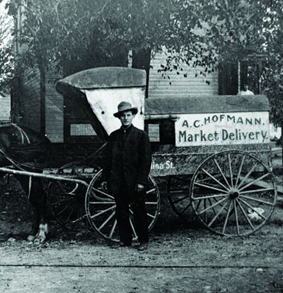
McKenzie’s Country Classics: Burlington, VT
John and Nellie McKenzie immigrated to Vermont in 1898 and developed their own farm. When Nellie began giving country hams as holiday gifts, word got out about the heavenly taste. The McKenzies never turned back. Today, McKenzie’s belief is, “Be good, do good, and bring good to as many people as we can.” This is why you will find only the finest meats and cheeses at McKenzie’s with no antibiotics or added growth hormones. They take pride in producing healthy, wholesome goods.

Martin Rosol’s: New Britain, CT
Martin Rosol opened his business in 1928 which took place in a converted garage with eight employees. The number of employees expanded as the business advanced with some working here for over 50 years! In addition to their store front, Martin Rosol’s also has an online store where you can find delicious kielbasa, sausage, frankfurters, and cold cuts. Martin Rosol’s manufacturers are famous for their “foot long” frankfurters! Check them out!
Chicopee Provision Co, Inc: MA
Chicopee Provision Co, Inc. has been open for almost 100 years! Not only have they been credited with manufacturing the world’s largest kielbasa, which was 600 pounds, they also take pride in their other delicious products. These include hot dogs, hot and sweet sausages, baked loaves, and more. There is quite a history with this business. The founders faced severe setbacks throughout the years. Flooding from the Connecticut River caused incredible damage to the plant and inventory in 1936, 1938, and 1955. During World War II, the plant almost closed due to the lack of beef and pork. While the war lasted five years, the company withstood these challenges and continued to be a favorite many years later.

Dino’s Sausage: Utica, NY
Originating in 1969, Dino’s Sausage began as an Italian deli before developing into a wholesale provider. Dino’s has gained a reputation over the years for providing superior meats as well as having a delivery service you can count on! Some of their products include Italian sausage, ground port, stick or sliced pepperoni, boneless chicken breast, portioned steak, and much more!
Dietz & Watson: Philadelphia, PA
Dietz and Watson a family-owned business, began in 1939. Their mission is, “To provide the best meat and cheese products on the market by adhering to our guiding principles: choice, quality, transparency, and family.” In addition to fine meats and cheeses, Dietz & Watson has a variety of snacks and condiments that are the perfect pairing for any meal. You can also find recipes on their website that fit all different needs. These include: gluten free, low sodium, keto, game day, vegetarian, and more.

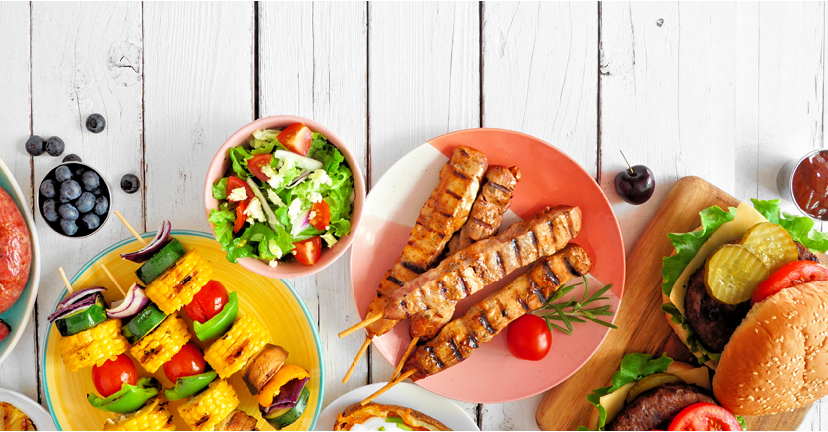
Mia Teal
Marketing Coordinator, Paid Media
The month of July has so much to offer. The weather is beautiful, school is out, and everywhere we look there are barbecues and picnics. It only makes sense that National Grilling Month is celebrated for the entirety of this month! When we think of firing up the grill, hot dogs and hamburgers are most likely the first thing to come to mind. However, there are actually an array of items that can be grilled. Some may even surprise you. Let’s take a look below!
Watermelon: Grilling watermelon is actually quite simple. If you are new to the whole “grilling fruit” idea, then you are in for a treat. Picture the juicy sweetness of watermelon with a smoky flavor. It is quite the combination. The watermelon should be cut into wedges and placed on a heated grill for two to three minutes. Some people may add sugar or spices, or just eat it plain.
Pineapple: Grilled pineapple is a must-try this summer. They can be cut in rings, wedges, or cubes. Many people brush the pineapple in butter and/or brown sugar, but that is optional. Lightly oil the grate and cook pineapple for two to three minutes.
Bananas: If you are a banana-lover, then you are in for a serious treat! To grill bananas, slice them down the middle with the peel intact. Place the cut-side of the banana on the grill and wait to see grill marks (should only be about two minutes). An option here is to sprinkle on sugar or honey. Using tongs, flip the bananas over for five more minutes, or until the peel starts to pull away. This is best served with vanilla ice cream. Speaking of, Price Chopper and Market 32 have a new line of PICS Pint Ice Cream! Check them out here.
Tofu: Looking to change up the way you eat tofu? Look no further! Grilled, seasoned tofu is a delicious summertime meal. You will want to buy firm or extra firm tofu, not soft. Press the excess liquid from the tofu prior to placing it on the grill, and make sure you oil the grill so the tofu does not stick. Cut tofu, paint with your marinade of choice, and then throw on the grill for two to three minutes each side. There you have it – Quick, easy, and anything but boring!
Pizza: If you have never grilled pizza before, then stop what you are doing and read this! Place the plain, formed dough on a cookie sheet and gently slide it onto the heated grill. The key here is to grill the dough on both sides, and then remove from the grill. Once you notice it starts to brown on one side, use tongs to flip. Once both sides are browned, let the crust cool on a rack for a few minutes to two hours. When you are ready, add your toppings and place back on the grill for two to three minutes.
Be sure to browse all-things grilling below for more traditional barbecue food!

Dairy Delivers Sustainable Nutrition
Ellie Wilson
MS, RDN Manager of Lifestyles and Wellness
June is National Dairy Month! My Facebook memories are showing me pictures of many visits to dairy farms across New York State, where I learned about the ways dairy farmers are innovating in animal care, land and water management. The dairy industry has sustainability built into its DNA – farmers are diligent about managing their family farms from generation to generation. They’re always looking for smarter ways to do work, such as using technology, like cow exercise trackers to monitor health, and milk tank temperature systems that text the farmer if the temperature changes. The result of this good stewardship and passionate care is a nutritionally amazing product that delivers sustainable nutrition. This definition is really about the ongoing science-based pursuit of providing affordable, accessible, nutrient rich foods that can nourish the world’s growing population, while also protecting environmental resources now and for future generations.
The foundation of dairy sustainability is the biology of cows themselves. Dairy cows have 4 stomachs, which means they can eat a wide range of foods/plants other animals cannot eat and produce a nutrient rich product. They also produce manure, which is regulated and managed in multiple ways – for example, many farms have digesters that extract liquid and gas from manure, turning that into fertilizer for farm fields and energy for the farm and community. The fertilizer supports grass and cover crops that protect topsoil. Cows are also up cyclers of food waste – citrus pulp, almond hulls, leftover pumpkins and fruits and vegetables are all on the menu, reducing food waste and bringing nutrition benefit back to the food system.
Water is a valuable resource on dairy farms. It is recycled several times as drinking water for cows, to cool them when it’s hot, wash farm equipment and clean the barn floor. After cleaning barns, nutrient rich water can be collected and used to fertilize fields. Data tells the sustainability story best – research shows the amount of water needed to produce a gallon of milk declined 30% over a 10-year period. Overall, the dairy community has reduced the carbon footprint of milk by 63% over a recent 10-year period due to improvements in animal health, cow comfort and farm management practice. Looking ahead, they have committed to an ambitious net zero carbon emissions by 2050. Climate change mitigation is evident in how they produce the same amount of food using fewer resources but still providing great nutrients and great flavor – the 13- nutrient package that is milk and all the things we can make from it is a fantastic result of a constantly improved process. America’s dairy farmers have set aggressive new environmental sustainability goals to achieve greenhouse gas neutral neutrality, optimize water uses and improve water quality.
Dairy farm families have a long-term investment in environmental care. That torch is passed from generation to generation. I have met many of these families and could only be impressed by the dedication to their work. Cows are the center of the dairy farm and caring for them is a passion and a priority, 365 days a year. You and your family are part of the sustainable nutrition cycle and benefit as well – one of the best ways to add nutrition value to any meal or snack is to enjoy a glass of milk or add fun to any afternoon with a bowl of ice cream! Take a virtual tour of a dairy farm and learn more about where delicious dairy comes from!
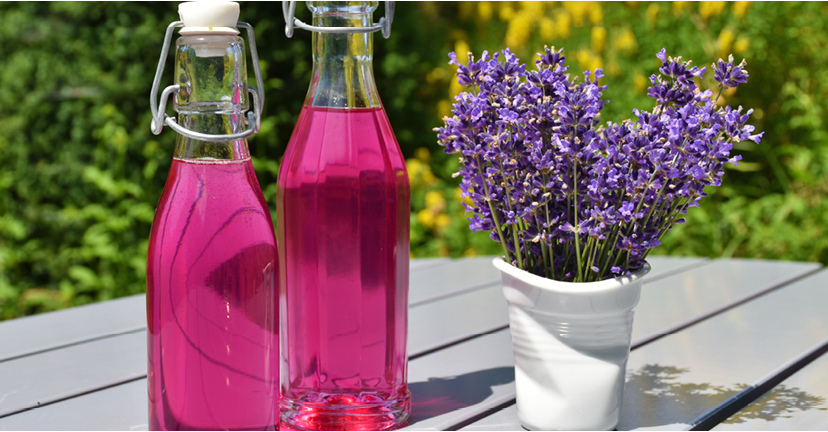
Haleigh Eustis
Floral Intern
Summertime is approaching faster than ever and what better way to beat the heat than with an ice-cold glass of lemonade? Nothing! Even though lemonade is a wonderful drink, it can taste a bit boring at times. Practically everyone knows the signature flavor of lemonade, as it’s a classic summer staple, so why not mix it up a bit!
Simple syrup is an easy and exciting way to create a different taste to any drink. The possibilities are endless when creating this quick simple syrup. Add virtually anything to create a fun and unique take on a drink that we all love! Add fruits, herbs, spices, and flowers to simple syrup.
That’s right, flowers can be used to flavor simple syrups! Their floral and decadent scent can easily be mimicked into any drink. Though not every flower can be used in simple syrup, lavender is a popular flower that is commonly used in lemonades, coffees, teas and so much more!
If you would like to try a fun simple syrup that adds some excitement to your summer, then follow this recipe that breaks down how to create the perfect staple syrup for your summer!
What You Need:
- 2 or 3 Teaspoons of Edible Lavender (Dried or Fresh)
- ¾ Cup of Granulated Sugar (You Can Use Honey as Well)
- 1 Cup of Water
Instructions:
- Pour your cup of water into a pot and bring to a boil.
- Once your water is boiling, pour your cup of sugar in the pot along with 2 or 3 teaspoons of lavender.
- Bring your mixture to a simmer. (You don’t want the sugar to burn as your lavender steeps!)
- Stir the sugar until it’s completely dissolved and let the liquid simmer even more.
- Wait 10-15 minutes to acquire the perfect lavender taste, best suited for you! (Feel free to taste test and play around with flavor intensity in this step.)
- Strain your simple syrup with a mesh strainer (double strain to ensure no buds!)
- Once your syrup has cooled fully, place the syrup in a bottle and store in the fridge. (Your simple syrup will last for two weeks!)
- Add desired amount of syrup to any beverage.
There you have it! An easy and carefree simple syrup that takes minimal time and adds an exciting, new flavor to any drink. Replace lavender with fruits and other (edible) flowers to create a variety of syrups all summer long! Shop all your simple syrup making needs at Price Chopper and Market 32.
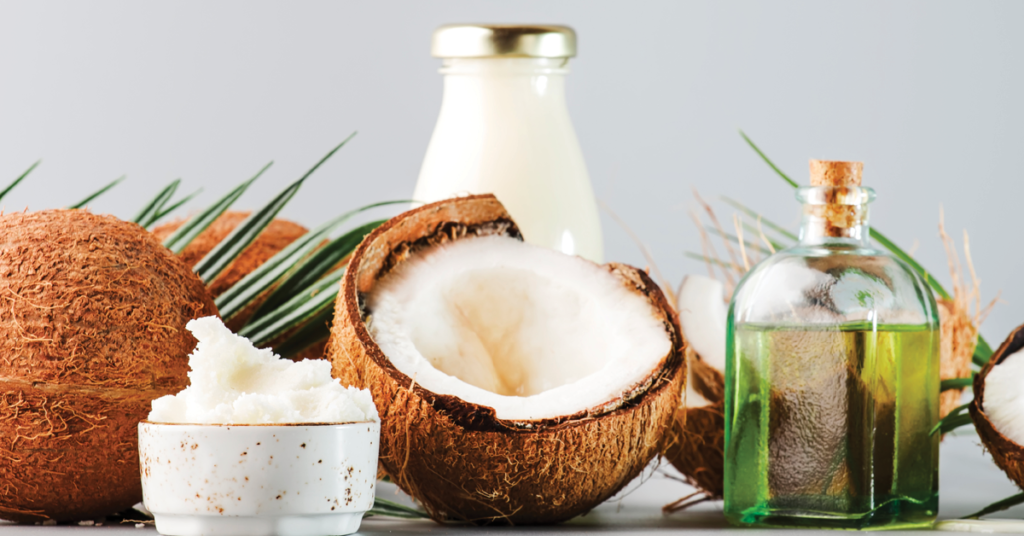
Mia Teal
Marketing Coordinator, Paid Media
Happy National Coconut Day! Yes, coconuts actually have their own day – June 26th. This tropical fruit may have you dreaming of being on an island, piña colada in hand, and not a care in the world. Whether you are reading this in your office building, by a pool, or a tropical beach if you are lucky, we have everything coconut-facts and tropical fruit recipes!
A question that many may wonder is whether a coconut is a fruit, nut, or seed. While the word “nut” is in “coconut,” that can be misleading. Coconuts are considered a fruit that have a hard shell enclosing the coconut seed.
Coconuts need high humidity and frequent irrigation to grow and survive which is why they flourish in tropical regions. Today, the Philippines are the largest producers of coconuts, with Indonesia and India closely behind. In the United States, coconuts grow in Hawaii and Florida. While the origin of coconuts is still up for debate, there have been fossil records of coconuts found in New Zealand dating back to 15 million years ago!
Another surprising fact about coconuts is that there are different varieties of them. A few of many are listed below!
- Malayan Yellow Dwarf Coconuts: These coconuts were first found in the Malaysian area between 1800 and 1900. When they are still immature, these fruits will appear a pale green but eventually turn a pale yellow to brown color.
- Fiji Dwarf Coconut: Popular in Florida, the Fiji Dwarf Coconut tree is known to grow copious amounts of coconuts while being remarkably short in size.
- VHC1 Coconut: This coconut tree is incredibly large and produces the fruit once every four years!
- Macapuno Coconut: The meat of this coconut is jelly-like due to natural mutations and are primarily grown throughout Asia. Interestingly enough, the Macapuno Coconut is considered a delicacy where they are grown in Asia and are much higher in price compared to other coconuts.
Coconut is widely used in baking and cooking, and coconut water has some great health benefits. Coconut flour is a great alternative for those that are gluten free and coconut milk works for those who are lactose intolerant. Additionally, many yogurts, creamers, and whipped cream are now made with coconut milk. When it comes to cooking, many people use coconut oil for cooking and frying, and there are even varieties of coconut spray to coat the bottom of your frying pan for a lower calorie option.
While coconut meat is relatively high in calories and fat and should be eaten in moderation, coconut water is great for the body. Many athletes drink coconut water for rehydration after an intense workout, but there is no evidence that supports the fact that coconut water is more hydrating than plain water. Also, coconut water has between 45 to 80 calories per eight ounces. Unsweetened and unflavored coconut water tends to have less calories than its counterparts.
Today, many beauty products are made from coconuts to moisturize the skin and hair. Who knew that these little fruits could have so many benefits other than just being delicious!
Interested in incorporating coconut in your cooking and baking? Check out some fun recipes below!
Coconut-Ginger Key Lime Bars: These cool, refreshing bars are the perfect way to celebrate National Coconut Week!
Tropical Daiquiri: Nothing screams “National Coconut Week” like this Tropical Daiquiri! Be sure to pick up PICS coconut milk. Honey, and ice at your local Price Chopper or Market 32.
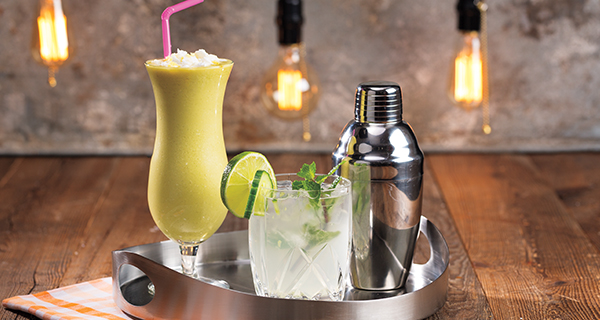
Magic Brownie Bars: Name a better combo than coconut and chocolate. Well?
Instant Pot® Coconut-Curry Lentils with Tofu & Vegetables: This is the best time of the year for fresh produce! Mix your veggies in with tofu, coconut milk, lentils, and more for this hearty lunch or dinner.

Happy National Coconut Day!

Mia Teal
Marketing Coordinator, Paid Media
Quality you can see and taste! PICS Peanut Butter is made in the Northeast from U.S. grown peanuts. Whether a savory or sweet dish our natural Peanut Butter is the star. Only at Price Chopper & Market 32.
Peanut butter is a staple in many households. It is a delicious, filling, and easy spread that has been used in the classic pb&j for years. The great thing about peanut butter is that it is so versatile. Nowadays, you can find thousands of recipes with peanut butter, ranging from peanut butter smoothies, to thai peanut sauce, to peanut butter s’mores (check it out below)!
When people think of recipes with peanut butter, they may think of something sweet like peanut butter cookies for example. However, there are actually many savory recipes that can be made with peanut butter, like chicken with peanut sauce! We are here to change your peanut butter game. At Price Chopper and Market 32, we have a wide variety of PICS Peanut Butter and peanut butter recipes on our website. Take a look below for some inspiration!
Asian Chicken Lettuce Wraps: This recipe is an easy & refreshing summertime recipe. If you have liked lettuce wraps in the past, then you must try this one!
Thai Shrimp Zoodle Bowl: Not only does this recipe contain PICS Peanut Butter, but it also calls for PICS Peanuts as well. Calling all peanut-lovers!
Grilled Chicken Saté with Peanut Dipping Sauce: No more boring grilled chicken – Spice it up this summer with this delicious recipe. You will not be disappointed!
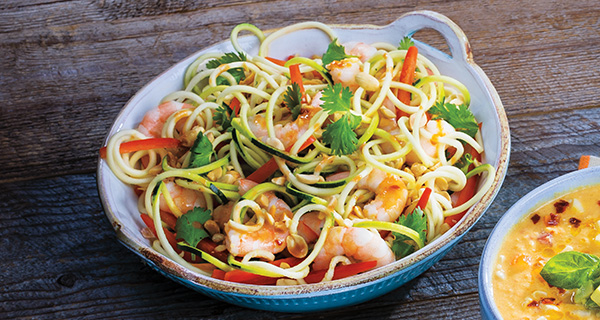
Now for the moment you have been waiting for – PB & J S’mores! If there is any recipe that is a must-try this summer, it is this one!

Haleigh Eustis
Floral Intern
Wedding season is in the air! A magical day filled with beautiful dresses, delicious desserts, stunning décor and . . . flowers! With every wedding comes the important decision: What flowers are going to be used to create your picture-perfect day?
Brides have been known to carry bouquets to ward off bad luck on their special day. Whether you believe this, or you just think they look pretty, a floral bouquet is an elegant way to add some personality to your wedding.
As the years have passed, it’s become more common for brides to create a beautiful bouquet of flowers that’s perfect for their liking. Though this may seem like an easy task, there are proper steps that go into bouquet assembly to create the most attractive bundle of flowers. If you’re planning on DIYing your own bouquet for wedding season, here’s a helpful guide to get you started!
To create a beautiful bouquet, focus on four key elements: focal flowers, fillers, linear flowers, and volume focal flowers. Each element will ensure a lively and stunning bouquet that will impress your guests!
Focal Flowers: A focal flower is, essentially, your base. Usually, a base is created from one to three flowers. From there, you create a bouquet that is centered around those flowers. The focal flower(s) is the crème de la crème of your bouquet! Normally focal flowers are larger in size and the most attractive flower of your bouquet. Examples of popular focal flowers: roses, hibiscus, and sunflowers.
Fillers: A filler usually is something that is used to cover or fill unwanted or awkward gaps. It may add color contrast to the bouquet, but essentially, it is aiding the focal flower! Popular fillers: baby’s breath and eucalyptus. Small and easy to find, fillers are wonderful for creating dimension and texture.
Linear Flowers: Though it’s not necessary, a linear flower(s) is a quirky addition to add flare in a bouquet. Linear flowers are used to add height, which may not always desired. Popular linear flowers: campanula, snapdragons, and gladiola. Linear flowers are an easy way to add texture and dimension to a bouquet. But be careful! Too many linear flowers could take away from your actual focal flowers. Utilize linear flowers graciously.
Volume Focal Flowers: Last, but definitely not least, volume focal flowers! These are meant to bring the entire bouquet together nicely. Volume focal flowers consist of small bundles of beautiful flowers. Typically, these flowers should be simpler. They accent–but don’t take away from–the focal flower(s)!
Creating a beautiful bouquet doesn’t have to be stressful! Follow this guide and anyone can create a showstopping flower creation effortlessly. To alleviate wedding stress, shop Price Chopper/Market 32 Floral Department for all your unique floral needs. Good luck!

International Sushi Day: A Guide to Get On A Roll
Jon Waiksnoris
Social Media, Digital Marketing
What did Sushi A Say to Sushi B? Wasabi!
June 18th is International Sushi Day! We love sushi and we’re proud to offer a modern approach to an age-old art form in our stores. Check out our unique selection of Aburi style sushi, where the fish is partially grilled and partially raw. You’ll also find favorites like the traditional California and Rainbow rolls, or more daring options like Crunchy Dragon and Shrimp Dynamite.
Sushi can be confusing…especially to those who are looking to order or buy it for the first time. Check out this guide of different sushi and sashimi options so you know what you’re getting into.
Nigiri: Nigiri is the original and most traditional style of Sushi rolls. They’ve existed for centuries and they’re probably what you picture when you hear the word “sushi.” Made up of an oval bed of seasoned rice topped with raw fish, seafood, or vegetables.
Maki Roll: Maki Rolls are traditional Japanese rolls prepared by rolling a layer of rice with different varieties of fish or vegetables inside. Wrapped with nori or seaweed on the outside.
Uramaki Roll: Uramaki Rolls are an Americanized-Style Sushi Roll, rolled with nori sheet hidden inside and topped with rice. Examples include, the traditional California Roll, Spider Roll with soft-shell crab, Tempura Roll, and Dragon Roll.
Temaki Roll: Temaki Rolls, also knows as Hand Rolls, are cone-shaped with nori sheet folded like a cone. With sushi rice and a variety of ingredients inside, easily eaten with your hands rather than chopsticks.
Sashimi: Sashimi differs from sushi; in that it is not made up of rice or nori. However, it is usually offered as an option at any sushi restaurant. Sashimi is made up of finely sliced pieces of high-quality sushi-grade raw fish or seafood served with soy sauce.
Sushi Hand Roll: Check out our recipe for a Sushi Hand Roll, aka Temaki Roll. Featuring Market 32 Shrimp, PICS Steamable Cauliflower Rice, an Asian style chopped salad kit, and tasty vegetables. It’s a great option for trying your hand at your own homemade sushi!
Shop Sushi
Source: https://itsyourjapan.com/beginners-guide-to-sushi-menu/

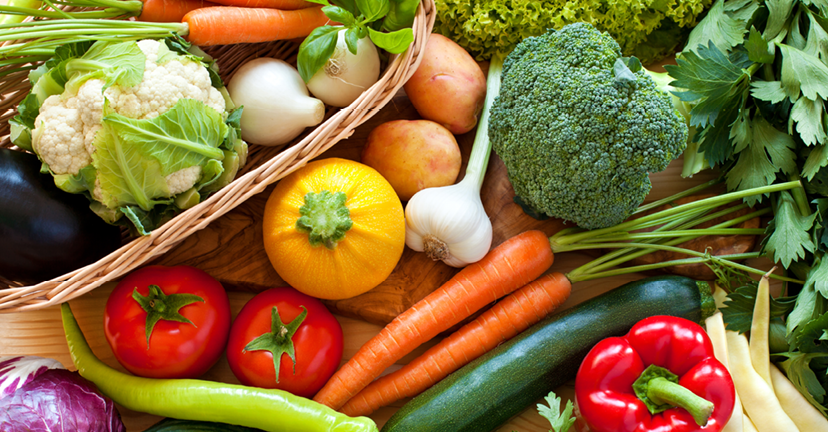
Mia Teal
Paid Media Marketing Coordinator
Crisp, colorful, and bursting with flavor, fresh veggies are the perfect addition to any summer meal. From tasty salads to zesty stir-fries, there are endless ways to enjoy these nutritious powerhouses. At Price Chopper and Market 32, not only do we have fresh veggies for you year round, but we also have a ton of recipes that you can make with them. What better time to try a new recipe than today, National Fresh Veggies Day!
I am sure we all remember the dreaded statement as kids: “Eat your veggies!” However, there are actually so many fun ways we can eat them, from dipping your carrots in ranch dressing to making a delicious stir fry meal. Oh, what about in a smoothie? The possibilities are endless when it comes to making veggies more appealing. Don’t believe us? Well, let’s take a look below…
Heirloom Tomato, Mozzarella, & Beet Stack: Nothing says summer like mozzarella, tomato, and basil. I can just smell this combo! This recipe combines the most delicious summertime ingredients for your next appetizer or light meal.
Mexican Street Corn: Have you ever tried Mexican Street Corn? Well now you can! These are so delicious, you will be coming back for seconds!

Carrot-Zucchini Chocolate Muffins: This sneaky way to get vegetables in your food is not only delicious, but easy too! Your child will love these.
Kicked-Up Green Smoothie: Enjoy this refreshing smoothie on a hot summer day to feel energized and rejuvenated!
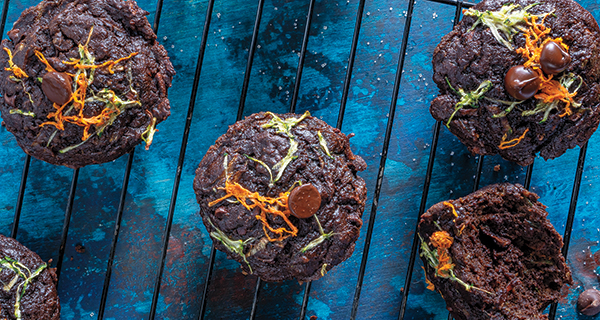
Looking for more inspiration? We have an abundance of on our Recipes Page, Price Chopper Ready Website, and YouTube Channel. We hope you enjoy fresh veggies not only on National Fresh Veggies Day, but all year long.

Written by our friends at Green Mountain Energy
Make summer barbecues more sustainable with eco-friendly ideas for a planet-friendly cookout. So before firing up the barbie, check out our grilling tips ranging from menu items to table decor.
Grill time
When it comes to firing up the grill, here’s how to keep it green:
- 1. Natural gas burns cleaner than charcoal.
- 2. If you have to use charcoal, there are organic and natural alternatives (often made from hardwoods) that burn easily with no chemical residue.
- 3. Make sure you’re heating your grill only for as long as you need.
- 4. And clean out your grill regularly to make sure you’re using it effectively!
On the menu
From snacks to desserts, you can easily reduce the carbon footprint of your meal. Give the following a try:
- 1. Beef production creates 11x more greenhouse gases than plant-based foods — and with all the meatless alternatives out there, it’s time for a swap!
- 2. If it’s not summer without a burger for you, another option would be to use turkey or chicken. They both have a lower carbon impact than their meatier counterpart.
- 3. Shop for local and in-season fruits as a fresh and healthy appetizer alternative.
Décor and tableware
When it comes to decorating and table setting, making it simple also helps make it sustainable.
- 1. Reuse decorations or invest in some that can be used more flexibly. For example, a chalkboard can be decorated with a festive message to help set the theme any time of year.
- 3. Get creative with art supplies and recycled goods. Think about streamers made from shredded paper or flags painted on cardboard to really keep your carbon footprint low.
- 3. Use your everyday flatware instead of plastic utensils. This one is fairly simple — it eliminates plastic waste and makes good use of what you already have.
- 4. And for a pop of color, incorporate greenery from your backyard into your table arrangements.
Green grilling
We hope you have plenty of fun, green Summer cookouts and look forward to sharing more tips about helping protect our planet. To stay in the know, subscribe to our monthly newsletter.
Living greener doesn’t have to come with higher food costs. We’ve partnered with Market 32 to make going green even more rewarding, featuring 100% renewable energy plans that let you save at the checkout line. Learn more here.


